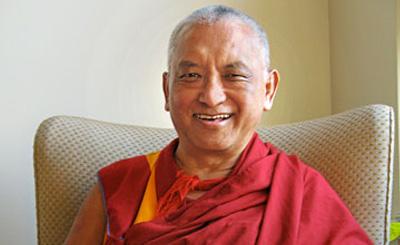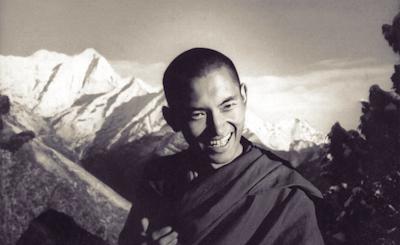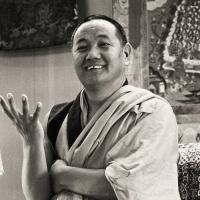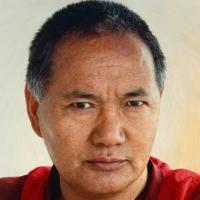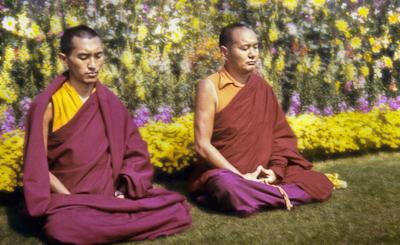The cow on the precipice
The great pandit Chandragomin uses a very effective example to explain the nature of worldly beings who work only for this life. A cow sees a small tuft of grass growing at the edge of a precipice and runs toward it thinking that if she can eat it she will be happy. Because of her attachment to the grass, she finishes up falling over the precipice, killing herself. Her attachment brings her suffering instead of the happiness she expected. Chandragomin said that worldly beings seeking only the happiness of this life are just like the cow. Without seeing the danger that their attachment to pleasure conceals, they run toward it and fall down and die.
This example is incredible. Since we seek solely the happiness of this life and are attached only to that, everything we do becomes nonvirtue. Like the cow that falls over the precipice trying to get the happiness of the grass, we’re totally cheated by attachment. Even though we’re looking for happiness, our actions only result in rebirth in the lower realms.
Lama Atisha, the great yogi and scholar, was invited to come from India to reestablish Buddhadharma in Tibet. The bodhisattva Dromtönpa, an emanation of Avalokiteshvara, the Buddha of Compassion, was Lama Atisha’s translator and offered service to him in Tibet. Once he asked Atisha, “What are the results of actions done with ignorance, attachment and anger and those done without ignorance, attachment and anger?” Lama Atisha replied,
Actions done with ignorance, attachment and anger bring rebirth in the lower realms as a suffering transmigratory being. Ignorance causes rebirth as an animal, greed causes rebirth as a hungry ghost and hatred causes rebirth as a hell being. Actions not possessed by the three poisonous minds bring rebirth in the upper realms as a happy transmigratory being.
To understand Lama Atisha’s answer, look at human beings who have not the slightest understanding of Dharma, who have no faith in refuge or karma, such as people from your own city or town. Day and night they think of nothing more than this life. They’re concerned about nothing more than the happiness of the next few years, or even the next few months. They constantly keep themselves busy with this motivation of worldly concern. It’s easy to see that this is all nonvirtue. Lama Atisha explains that all actions of body, speech and mind done with an attitude of worldly concern result in rebirth in the lower realms as a suffering transmigratory being.
Because they have no faith in refuge and no understanding of karma, such people have no opportunity to practice holy Dharma, no opportunity to purify their previously accumulated obscurations and negative karma. We can see this very clearly in the example of the cow, who is so determined to get the grass that she is blind to the danger of the precipice and kills herself trying to get it. Like this, since the method is nonvirtue, the result of everything done for the happiness of this life is rebirth in the lower realms. Even if worldly people are shown the teachings on refuge and karma or given purification methods such as Vajrasattva, they cannot understand or accept them and therefore have no opportunity to practice Dharma.
We should feel extremely fortunate that we have met the holy Dharma. Even though we might still create negative karma, at least we have the opportunity to purify it. With an understanding of karma and refuge we have the opportunity to practice Dharma and know there is a solution. This is Dharma wisdom: it opens our eyes to the precipice before us and gives us the tools to avoid it.
One of Atisha’s followers, the great meditator and Kadampa master Sharawa, makes it clear that no matter who we are, all our problems are created by the thought of the eight worldly dharmas. This is just as true for somebody on a spiritual path trying practice Dharma as it is for somebody who doesn’t follow any religion. If we don’t renounce the thought of the eight worldly dharmas we’ll always experience many problems and be unable to develop our mind.
All the problems we experience—from not sleeping to thoughts of suicide—arise from attachment. This is simple Buddhist psychology; it clearly shows the source of both all our problems and all our happiness. This science of the mind is so logical; studying it brings us peace as we come to understand how all our problems are rooted in the mind.
We will see this clearly if we bring to mind all the problems we’ve recently experienced—last year, the year before and so forth, back as far as we can remember, and analyze the cause of all those problems. If we investigate honestly, we won’t find even one problem that was not caused by the thought of the worldly dharmas.
We can also take our investigation beyond our own problems to those that others face—our family and friends, the people we work with and so forth—checking whether their problems also stem from the thought of the eight worldly dharmas. By doing this we’ll become very much more aware of the nature of the mind.21
Humans, animals: the only difference is the shape
Ultimately, there’s very little difference in the lives of those beings ruled by the thought of the eight worldly dharmas. To a beggar, a businessman looks rich, but even though superficially they lead different lives, below the surface, they’re the same—both are simply working for the happiness of just this life; both ways of living are negative; both are worldly work. There’s no real difference.
In some ways, the beggar’s life is preferable. Many businessmen take care of their lives by cheating others, and cheating others means cheating themselves, because cheating others takes cunning, treachery and telling lies. In general, beggars don’t cheat others, therefore their lives are not as negative.
Students aren’t much better. They study hard from childhood until they graduate with a degree from a top university, but it’s all just to take care of this life. They might think that they are working for the good of their country or for world peace, but in the depths of their heart their main goal is only the comfort of this life. So even if it takes thirty, forty or fifty years for them to get their degree, they remain servants of the eight worldly dharmas.
Then, no matter how high up the career ladder they climb, since everything they do is for the comfort of this life, they never become anything more than servants of the eight worldly dharmas. And what if they die three or four years after graduation? Having studied so much and worked so hard, what do they have to carry with them? Nothing! They can’t take their fat bank accounts along. All they can take with them to their next life are the imprints on their mindstream of all the actions they’ve done from the time they were born and beginningless lives, and those are all negative due to their attachment to mundane comfort. They worked all their life to create the cause of suffering, and this is how their lives finish. If we really check up, this is the huge tragedy of life.
In this way, a student is no different from an animal. A cow stays near her home, eating grass and sleeping. She can’t talk and knows nothing the student knows—she hasn’t even studied her ABCs. She certainly hasn’t gained a degree. Her whole life of ten or twenty years is spent trying to find the best grass and water she can. From birth until death, her whole life is dedicated to the comfort of this life, exactly the same as that of the student.
We can easily see that everything that animals do—going to the fields, coming back, eating, drinking—is motivated by attachment, clinging to this life. I haven’t heard whether they watch television or go to the movies, but it’s possible. I’ve heard that in the United States there are schools where animals are trained how to live in a house—where to sleep, where to eat, which chairs to sit on, where not to make smells. In the East, people teach dogs to make prostrations but that doesn’t make their minds understand Dharma; it’s only a physical action. They make prostrations when there’s meat, when they’re hungry. At night, they go to sleep with no virtuous thought or pure motivation.
If we analyze the lives of the student and the cow, they’re basically the same. Just as the cow’s life is negative, so is the student’s. The cow’s life is no higher than the student’s; the student’s life is no higher than the cow’s. When death comes, the student will have done nothing higher than the cow, even though he was born as a human being.
However smart he is, however great his reputation, whether he dives down to the depths of the Pacific or flies up to the moon, since his life is motivated solely by attachment to the comfort of this life, it’s all negative, all the cause of suffering. His way of looking for happiness might seem a little bit different from that of the cow, but it’s certainly no higher. Everything both of them do is motivated by the impure thoughts of greed, hatred and ignorance and keeps them trapped in the prison of samsara. One might have no possessions and lead a miserable life while the other has every possible material possession and great pleasure, but ultimately there really is not much difference. The only difference is the shape.
If a being has one shape we call it a human; if it has another we call it an animal. The actions are basically the same; the mind is the same. We might proudly think that we’re infinitely more competent than animals and that animals are low and uneducated, but if we really check whether our life is in any way more meaningful than that of an animal, we might get a bit of a shock.
How many animals are there in this world? How many people? Check up on the numbers and think about how every one of them is creating the causes of suffering because they’re controlled by the thought of the eight worldly dharmas.
First of all, think about all the billions of creatures in the ocean and what their minds are doing. If we could see into the minds of all those different types of fish, all those different creatures busily swimming back and forth, round and round, looking for food, seeking a safe comfortable place, all we’d find in the depths of their heart is the thought seeking only the pleasure of this life.
All the other creatures, too—the birds flying around in the air, the animals on the surface of the earth, the beings underground—what they have in the very depths of their heart is exactly the same thing, only the comfort of this life.
Now think about human beings. Take one city, like New York, and observe. Watch every person in that city; watch their minds. With the exception of only a few, they’re all doing the same thing with the same motivation as the creatures that fly, walk and burrow. They’re concerned with only the comfort of this life. Those flying in spaceships or airplanes, traveling in cars or floating on the water are all doing the same thing, all thinking in the same way. Their only concern is the comfort of this life, the pleasures of this life. Look closely at all the people and all the animals—you won’t find any difference.
Look at the people shopping, the people driving their cars, up and down, back and forth, always busy, day and night, night and day. What are they all doing? Why are they all working so hard? What’s in their heart? It’s the same thing, desire for the happiness of just this life.
Observe them. Everybody everywhere, so busy doing worldly work, is under the control of attachment, seeking the pleasure of just this life. Everybody’s too busy to think about Dharma but never too busy to do all this nonvirtuous work. Such an incredible number of suffering transmigratory beings.
We worldly people look down on animals, thinking that they’re stupid and low, but somebody who understands Dharma and knows about karma sees that we’re no different. The meditator sees us as totally obsessed by worldly concern and everything we do as suffering. We live in complete darkness, totally devoid of Dharma wisdom and completely unconscious of our actions.
We would probably argue that we’re not unconscious; we’re very conscious of what we’re doing. We know where to eat good food, how to make lots of money, how to work, how to do business, how to turn a profit, how to bargain, what the best consumer items are. Many people who pride themselves on their intelligence even think that animals don’t have a mind. To the meditator, however, human or animal, we lead our lives stumbling unconsciously into suffering, completely under the control of delusion. Seeing this, we worldly beings become the objects of the meditator’s compassion.
Slaves of the eight worldly dharmas
When we follow the thought of the eight worldly dharmas we’re just like a dog following its master. The man can be planning to harm the dog or even kill it, but the dog will always follow him because it expects to get some food, something for its happiness, no matter how uncertain that is. When we’re following the mind of worldly concern, then we too will chase the stick whenever our master throws it. So we must be careful.
For most of our life we give freedom to desire, the evil thought of the eight worldly dharmas, and happily become its slave. In return, it constantly abuses and tortures us and brings us many problems, one after another. As slaves to attachment, we’re never satisfied with what we have; we’re always looking for better and more. This endless quest creates much unhappiness in our life and in those of others. It causes us to create vast amounts of negative karma with our body, such as fighting with others, and our speech, such as saying hurtful words and so forth. We can even become suicidal when our desire doesn’t get what it wants—desire tells us to kill ourselves and we do what it says.
Relationships are common examples of how attachment enslaves us. They can be like addictions. Relationship problems can go on and on and on uncontrollably, making our life hell. Before being reborn in an actual hell, we experience hell in a human body. We feel completely trapped, suffocated; we can’t even breathe.
It can happen that when we first get involved with a desirable person, we’re extremely happy, completely attached and almost become one with that person, but then after a few days we’re not even talking to him and see him as a monster, an enemy. The whole situation—first the attachment, then the aversion—is created by the thought of the eight worldly dharmas. If you check up, it’s true, very true. I’m not making it up. I’m talking about what happens to all of us. The second situation, the aversion, is clearly confusion, but so is the initial attachment, even though we don’t see it as such.
Addictions come about because we’re slaves to desire. Think of alcoholics and drug addicts. Their lives become so unhappy and out of control that they can’t even do their jobs. The more drugs they take, the more they damage their lives, destroying their awareness and memory. Alcoholics find it so hard to stop drinking—it’s mainly a disease of the mind. They can see everything that’s happening, all the danger, but don’t pay much attention.
An alcoholic spends all his money on drink, then fights, shouts and becomes insensible. Returning home penniless and in a wretched state, he has a huge scene with his family, accusing his wife of things she didn’t do. He throws things around, smashing their possessions, then runs out of the house and backs his car out recklessly and drives off very fast, breaking all the rules of the road. Then he has a crash and damages his brain or gets killed, or the police throw him in prison. This whole disastrous situation comes from the mind controlled by the thought of the eight worldly dharmas.
This evil mind makes it impossible for him to stop drinking, even if he sees how dangerous it is. He thinks maybe two or three sips won’t hurt, but somehow he needs more. Then it’s the same as before and again his mind becomes more and more uncontrolled. He wants to kick the habit but his mind is weak, his mind of desire is too strong.
Addiction to cigarettes is no different. Smoking causes your nails to turn yellow, your lungs to turn black and your face to get wrinkled. And it pollutes your mind as well as your body. Smoking can also cause heart attacks, cancer and many other diseases from which it’s difficult to recover. All this is caused by the dissatisfied mind, the thought of the eight worldly dharmas.
It is said in the teachings that the evolution of things like ganja22 and tobacco is due to the wrong prayers of the maras, the evildoers who want to stop the Dharma from developing in the world, disturb its practitioners and destroy any peace and happiness that there might be in the world. Smoking disturbs the mind by polluting the vehicle, the body. It blocks the chakras, preventing virtuous thoughts from arising, hinders the quick development of realizations and is a huge disturbance for practitioners of tantra.
Besides making the smoker unhealthy, the smoke also sickens surrounding sentient beings and pollutes their minds. There are many sentient beings we don’t see, such as the white protectors who protect meditators. If a place is polluted by smoke, they leave. Sentient beings such as nagas also usually need a very clean place. The smell of tobacco smoke completely destroys the whole environment, like vast clouds of poison spread by a crop-duster.
The first time I went to America on Pan Am, the plane was full of smoke. I felt like I was asleep the whole journey. Also, when somebody was smoking down the road from Kopan, the wind would bring the smell up into my room. When you breathe, the smell goes into your heart and causes pain. What’s so special about smoking? You put a fire in your mouth and the smoke comes out your nose.
As long as we’re under the control of the thought of the eight worldly dharmas we’re suffering, even if at present it doesn’t seem like that. Allowing ourselves to remain under their control is infinitely worse than a parent dying or losing billions of dollars, neither of which can cause us to be continuously reborn in samsara. Being a slave to the evil thought of the eight worldly dharmas is the most dangerous thing, the one thing that will keep us dying and being reborn, always circling through the six realms.
We never recognize this internal enemy, this devil inside. Not only that, we serve our attachment as much as we can. When attachment is hungry, we feed it delicious food; when it gets cold, we give it warm clothes; when it gets hot, we give it air-conditioned comfort. We obediently follow whatever orders attachment gives. It’s like a king.
Pabongka Dechen Nyingpo compares the eight worldly dharmas to a female cannibal. At first a female cannibal is very sweet. She speaks very nicely, tells us she loves us and wants to take care of us, but if we trust her, she will control and then eat us. This is exactly what samsaric perfections do to us.
We worldly people keep a very close eye on our external enemies, but watching this mental enemy is many million times more important. When this inner enemy arises, we should constantly be conscious of it and not follow it or allow it to control or enslave us. Then we should use all our understanding to destroy it. Unless we do this, no matter how much we try to practice Dharma, we’ll just continue creating negative karma. The thought of the eight worldly dharmas is our most dangerous enemy, not just because it brings us confusion and suffering in this life, but more because it is the main cause for rebirth in the lower realms and makes us suffer there for many eons.
Samsara is suffering
All suffering comes from the mind
To have a peaceful, happy life free from problems, we must first find the cause of our suffering and then do whatever is needed to eliminate that cause. As the cause of all our problems is the thought of the eight worldly dharmas, the only way to develop true happiness is to destroy this evil thought. We need to flush it from our minds. We need to be brain washed! Once it’s washed out, then there’s true freedom, true peace. As long as it sits there in our mind there can never be freedom.
We normally think of desire as good, but if we really examine the nature of desire we’ll see that its nature is suffering. We can sometimes recognize this when attachment is so strong it overpowers us. At that time we can actually feel it as physical pain, and because we’re unable to let go, that makes the emotional pain associated with it even worse.
If we can actually see that the thought of the eight worldly dharmas that lives in our own mind is the real culprit, we can learn how to control our mind, to disengage ourselves from the influence of worldly concern. Then we’re really studying the best psychology. Without understanding the cause of life’s problems, how can we find practical solutions that really benefit and bring peace and happiness in this life?
The Kadampa geshes were great meditators who actualized the graduated path to enlightenment and completely freed themselves from this emotional mind, from all thought of the worldly dharmas, the dissatisfied mind of desire. In their texts, when they explain real happiness, real peace, they’re talking from their own experience. They explain that whether we experience happiness or suffering is entirely determined by our motivation and nothing else. Everything depends on what type of motivation we have. If our motivation is virtuous, our action becomes virtuous and we experience happiness; if our motivation is nonvirtuous, our action becomes nonvirtuous and we experience suffering.
Both samsara—these circling aggregates, the association of body and mind that is in the nature of suffering—and nirvana—the ultimate happiness of liberation—come from our motivation. That which we call hell and that which we call enlightenment also come from our motivation. Everything comes from our motivation.
Therefore, the mind is the creator of everything. From our positive or negative motivations come the actions that cause all the happiness and suffering that we experience. If we do all of our actions out of desire, clinging to this life, since our motivation is nonvirtuous, our actions become nonvirtuous—they become only the cause of suffering, not the cause of happiness. Actions we do with a motivation unstained by desire clinging to this life become the cause of happiness.
In this way, all problems are created by the mind. Of the four desirable objects and the four undesirable ones, from the objects’ side there is no difference: the first four good, the second four bad. It is our attachment to worldly pleasure that labels them as such. We like comfort, gifts, friends, praise, reputation and so forth, so we interpret those objects as good; we don’t like discomfort, enemies, blame and so forth, so we interpret those objects as bad. Problems arise from the way that we judge situations. The same person is sometimes a friend, sometimes an enemy.
Not only that, but, as Dharmakirti explains in his commentary on Dignaga’s Compendium of Valid Cognition, the mind controlled by the thought of the eight worldly dharmas is obscured and unable to get to the point, to see things as they actually are. Calm water is very clean and totally transparent, but we can’t see through dirty, disturbed water at all. Similarly, the attached mind can’t stay still; it’s always disturbed and obscured, like a sky filled with dust from a strong wind—everything is indistinct and blurred.
And because of that, even if we do something for somebody else, it interferes with the sincere attitude to benefit others without any expectation of getting something in return. When our mind is occupied by attachment, there’s no space for unconditional loving kindness and compassion for that sentient being.
Love mixed with desire is love created by ignorance. It’s not the same as real unconditional love; it brings no peace because the principal cause is the unsubdued, untamed mind. If we have dirt on our face we can’t expect to see a clean face when we look in the mirror. In the same way, a state of mind such as desirous love caused by confusion cannot bring happiness and peace.
Overwhelmed by desire, there’s no time to think about impermanence and death. In fact, understanding impermanence and death is the complete opposite to attachment, because when we think of impermanence and death, it’s impossible to see any point in being attached. So it’s the antidote to attachment.
When our mind is possessed by attachment we can’t see emptiness either. Attachment obscures the ultimate nature of the I, the aggregates and phenomena. And it interferes with renunciation as well. In this way, the thought of the eight worldly dharmas interferes with our wish to achieve liberation, even for just ourselves.
On the other hand, if we have a renounced mind, neither the four desirable objects nor the four undesirable ones are a problem. The renounced mind is a very healthy mind. It is unstained by attachment to this life and is free from such labeling. When our mind is not ruled by attachment, when it’s peaceful and calm and there are no obstacles, we can easily meditate on things like impermanence and death and the sufferings of others. And when we meditate on emptiness, it’s easy to get to the point.
Therefore, if we want to escape from the cycle of suffering quickly, it’s necessary to make a radical change. We need to come to understand that the future suffering brought about by our current delusions is far, far worse and far more dangerous than whatever immediate problems we’re facing at the moment. With such understanding, even if we work to eliminate our current immediate problems, we’ll use the right methods.
Real peace comes when we develop our devotion, compassion, renunciation, contentment, loving kindness, bodhicitta and wisdom understanding emptiness. Those minds don’t disturb our mental continuum at all but purify our obscurations and negative karma and lead us to the peace of liberation and to enlightenment. This peace starts when we abandon desire—we begin to develop true peace in our mental continuum the moment we free ourselves from the thought of the eight worldly dharmas and eventually experience it forever.
The nature of fire is burning, the nature of samsara is suffering
Seeking the happiness of this life is more harmful than having a poisonous snake coiled in our lap. At worst, a snake bite can kill us, but desire has the power to propel our next life into the lower realms. The thought of the eight worldly dharmas is a million times worse than AIDS or cancer. Having the disease alone, even having all 424 diseases23 together, without the mind of desire doesn’t make us unhappy or cause us to be reborn in the hell, hungry ghost or animal realms.
We may feel a degree of excitement when we obtain one of the four desirable objects but that excitement is in fact only agitation. We’re like a fish hooked on a line, an ant mired in honey or a fly trapped in a spider web—completely enveloped and utterly unable to break free. Like a cow eating grass at the edge of a precipice or a person licking honey from a razor’s blade, enjoying such pleasure is extremely dangerous.
When a moth flies into melted candle wax, it gets completely trapped. Its body and wings are so fragile that it’s extremely difficult to separate them from the wax. The texts say that it might be that the moth sees something beautiful, like a celestial mansion, right inside the flame, so it flies right into it and gets burned and trapped. It doesn’t think the flame will burn its body, otherwise it wouldn’t fly in, yet the more we try to stop it, the harder it tries get into the flame.
This tells us something about the nature of the animal mind. The moth has only expectations of peace and happiness; it has no desire to suffer. It doesn’t plan to fly into the flame in order to suffer. It flies in because it’s unafraid, and it’s unafraid because it doesn’t understand the danger. The moth wants happiness but the result is the complete opposite; it gets burned and dies. It’s very important to try to discover why it does this. This is real scientific enquiry, the essential study of natural science.
Just as beings of the animal realm—moths, flies, ants—bring suffering on themselves while seeking happiness, we also do many actions that create only suffering. That is the nature of the mind of desire. We get stuck to the object, so we have no freedom. In the same way that a bird with a stone tied to its leg is unable to fly, we’re tied by attachment to our objects of desire.
Among poisons, desire is the worst. Like poison, sometimes it causes terrible pain, sometimes a bit less, but nonetheless, pain is always there. Because of desire we have continued to circle in samsara since beginningless time. From the smallest animal to the biggest, from the poorest human to the richest, all of us who are only concerned with overcoming temporary problems fail to see that in doing so we’re actually creating the cause of more and greater problems in the future.
The nature of fire is burning; the nature of samsara is suffering. Just as it’s better not to put our finger in a fire and get burned, it’s better not to be in samsara and suffer. It’s no use keeping our finger in the flame hoping that the fire will get cooler. That will never happen. In the same way, there’s no use wanting to stay in samsara and not suffer. The whole point is to try to get out of samsara. Until we do, we’re going to have to accept that we’re going to suffer, and when something unpleasant happens we should think, “Of course this has happened. I’m in samsara. Whatever happens to me is going to be in the nature of suffering because this is where I live.” So there’s no point in worrying.
Whenever we encounter a miserable situation and reject it, thinking how unfair it is and how “this shouldn’t be happening to me,” we only double our suffering and exaggerate the problem. How much we suffer depends on how we think. If we’re able to accept unpleasant experiences we don’t get such a shock when they occur; because we’re expecting suffering we handle it much better when it arises. It’s like jumping into cold water: if we think it’s going to be warm we get a shock, but if we know it’s going to be cold there’s no great surprise. We know we’re living in samsara, so we’re bound to experience suffering because that’s its nature.
This awareness also helps us accept responsibility for our own suffering as we see it as the karmic result of previous negative actions we ourselves have done; we take responsibility for our own suffering and don’t point the finger of blame at somebody else. Instead of planning revenge on the person who stole our money, we understand that the theft was the result of our having stolen from that person in the past and that the suffering we’re experiencing is entirely our own fault, not the other person’s. Realizing that we’re the only one to blame and not wanting to experience the result again, we resolve not to create the cause of that suffering any more.
We can also see that having experienced it this time, the result of that negative action we created in the past has now finished and we won’t have to experience it again. Therefore, although it’s unpleasant, it’s also something we can feel happy about. In this way suffering also makes us more conscious, more careful of our actions.
Better not to itch than to scratch
In his Precious Garland, the highly realized pandit and Madhyamaka philosopher Nagarjuna, who restored the sutra and tantra teachings in India when they had degenerated, said,
There is pleasure when a sore is scratched,
But to be without sores is more pleasurable still.
Just so, there are pleasures in worldly desires,
But to be without desires is more pleasurable still.24
We’re probably afraid that if we sacrifice our desire we’ll sacrifice our happiness and be left with nothing. Not understanding that the nature of desire is suffering, we can’t see that there is a better happiness independent of any external sense object; a deep peace developed within our own mind. We can’t see that feeding desire is like scratching dermatitis.
Because scratching stops the itch for a short time it feels good, so we label it “pleasure.” There’s some relief but it’s still suffering, just a lesser degree of it. Worldly pleasures, such as eating, drinking alcohol, sexual intercourse and so forth are all the same in nature; they’re actually suffering but are called “pleasure” by our superstitious mind.
The second or third time we scratch an itchy sore the relief we first felt turns to suffering; then that suffering is doubled. In the same way, the harder we work at worldly pleasures, instead of giving us increasing happiness they always turn into suffering.
Eating relieves the suffering of hunger, so we think it’s happiness, but if we keep on eating it becomes very uncomfortable. When we move into the shade of a tree to escape the suffering of the sun’s heat we feel pleasure at the coolness for a while, but when we’ve cooled down we start to feel cold and our pleasure turns into suffering. Soon we have to go back into the sun again to get relief from the cold. There are thousands of examples like this.
Rather than labeling the relief of scratching an itch as pleasure, wouldn’t it be better to be free from itchy sores completely? In the same way, it’s far better not to have the desire for worldly objects than to have the objects of worldly desire. Conflict arises because desire exists in our mind, the creator; if we’re free from desire there’s no way for problems to arise when we encounter objects. Therefore, giving up the eight worldly dharmas does not mean making these eight objects non-existent; it means making attachment to them non-existent.
Without desire, the problems that come from desire could not arise and there’d be no samsara. Without this body caused by delusion and karma and contaminated by the seed of disturbing thoughts we wouldn’t have to experience hot and cold, hunger and thirst and all the other problems that fill our lives. We wouldn’t have to worry about survival or spend so much time and money looking after our body. Think of how much time we spend just keeping this body looking good, how much work we put into decorating it, from our hair down to our feet. When we get sick, however, even medicine cannot always help, so wouldn’t it be better to be free from all these problems and not have this body, this samsara, at all?
Blame delusions, not others
There’s desire we should avoid and desire we need and many people don’t understand the difference. Negative desire, the desire we should avoid, is the desire for the pleasures of this life. We should avoid it because, as we have seen, this desire is the creator of all suffering. On the other hand, we need the desire for enlightenment. That’s what makes us follow the path and eliminate the cause of suffering and thereby achieve the goal of ultimate peace and enlightenment. Without that desire we’d have no energy to follow the path and achieve enlightenment.
Similarly, while aversion in general is negative, we need aversion to suffering in order to have the energy to strongly follow the path. Say we’re strongly disgusted with living in the West and really want to go to the East. The stronger our aversion to the West, the more avidly we’ll try to get to the East. In order to get there quickly, we take an airplane, not a bus. Just as aversion to the West and desire for the East is what we need to get us to where we want to go, aversion to suffering and the desire for enlightenment are vital to get us out of suffering.
Since, as Buddhist practitioners, we’re supposed to get rid of desire, we might think that all desire, including the desire to meditate, is somehow wrong; that even that is just another desire to be eliminated. In fact, the Buddha himself said, “If you desire all happiness, abandon all desire.” We should realize, however, that whatever Dharma activity we do motivated by the desire to achieve enlightenment is not attachment but is, in fact, very positive. If that kind of desire were a problem I wish that everybody had it. When that desire is there day and night and we can’t stop it, when it’s there while we’re eating, talking, sleeping—every moment—we have incredible energy to be quickly released from suffering.
We all have aversion to suffering, but generally our aversion is only to the gross worldly suffering perceived by our limited mind—the suffering of suffering—and not to all suffering or, in particular, the cause of suffering.
We’ve had aversion to temporary, worldly suffering for countless lifetimes but we’re still not out of samsara, so this proves that aversion in general doesn’t help. What’s missing is aversion to the very cause of suffering, without which we don’t have the energy to develop the mind that renounces all of samsara. That aversion is the rocket fuel that gives us the energy to practice.
Without seeing the thought of the eight worldly dharmas as the enemy we won’t develop the desire to be free of it. From beginningless lifetimes it has played at being our best friend and we’ve blindly followed it assuming that it will bring us happiness, but now we need to wake up and see that its real intention is to harm us. When we truly understand that this evil thought is the actual cause of all our suffering we’ll naturally want to destroy it. To hate and wish to destroy another being is wrong, but to hate and wish to destroy the cause of all our suffering is the wisest thing we can do. Destroying the enemy in our mind is the way to achieve perfect happiness without giving even one atom of harm to other sentient beings; this is the most beneficial way to gain ultimate peace.
Trying to achieve happiness by following the thought of the eight worldly dharmas almost always involves harming others and because of that the path to peace is blocked. It is like being a businessman who trades in pearls from Asia but sends his ships to the West instead. No matter how many eons he looks, he won’t find any pearls; he only gets exhausted and never finds success.
We have only one enemy and that’s the deluded mind of attachment clinging to this life. It has constantly robbed us of happiness and caused us great suffering in the past. It’s the cause of all our current suffering and it will continue to make us suffer in the future. If we find ourselves angry at another person, fighting and hitting him, we should stop and think that in fact he isn’t the one who should suffer. The one who should suffer is the actual creator of the situation, the real enemy—the evil thought of the eight worldly dharmas we harbor in our mind. The person we’re beating is innocent, having been pushed into the situation by his delusions, but it’s our own deluded mind that’s the root cause.
Normally when somebody does something really bad to us, the more we think about that person, the angrier we become. Our hatred gets stronger and stronger and we really want to kill her. Now, instead of hating the external enemy and trying to harm her, we turn on the internal enemy, the only true enemy, the one who makes us suffer all our problems and difficulties. The more deeply we think about the countless different problems the thought of the eight worldly dharmas has given us throughout infinite time, the stronger our aversion to it becomes and the easier it is for us to stop creating negative karma and experiencing the suffering result. This is the way we guide ourselves.
This also means that instead of suffering becoming an obstacle to our Dharma practice, it becomes a support for it. We can even use our suffering to cut problems altogether, depending on how well we understand the shortcomings of following the thought of the eight worldly dharmas.
Whenever there’s a physical or mental problem such as headache, hunger, depression and so forth—any problem that causes us to suffer—we can turn our suffering into Dharma by thinking that we’re suffering because of our negative mind, not because of the external conditions. In the past this negative mind has prevented us from achieving both ordinary samsaric happiness and true Dharma happiness—such as the cessation of samsara, bodhicitta, the realization of emptiness and enlightenment—it’s preventing us from achieving all this now, and it will continue to prevent us from doing so in the future. We need to really feel that this is so and not just say the words; words alone are ineffectual. The deeper our understanding, the greater the effect on our mind and the more clearly we see the negative mind as the real enemy.
For instance, hunger and thirst can disturb our meditation but by giving that suffering back to the delusions we can realize that that feeling is not “ours” as such. If we can do that, the suffering feeling weakens and can, in fact, disappear completely. Afterwards we won’t even know how it disappeared. Instead of disturbing our Dharma practice, our suffering becomes useful. There’s no need to interrupt our meditation to get a drink of water. Our mind created the problem but has cured itself. This is such a nice method.
Meditation
Meditation on the nature of attachment
A very useful meditation on the eight worldly dharmas is to check the root of your problems. In your meditation session you should investigate whether or not your life has lived up to your expectations. At the beginning you expected your life to be happy—either by always having whatever material possessions you desired or by always being with one particular person or something like that—but did that happen? If you’ve had any problems, trace them back to their root to see why they happened. What was the cause of this problem or that? Not just the immediate conditions that triggered it but the real, main cause? Investigate. Go back further and further in time and you’ll find out. You’ll see that you’ve been expecting a kind of happiness that’s just not realistic. And if you trace the evolution of this problem back as far as you can you’ll discover that the root of this and all your other problems is one thing: the thought of the eight worldly dharmas.
When attachment arises, check to see whether you feel happiness arising with it. Compare real happiness with the “happiness” your mind feels when it comes into contact with an object of attachment. Is it real happiness or does your mind just label that feeling happiness? Try to see that the nature of that mind is tight, not free.
Watch how your mind wants to run to an object of attachment and wrap itself up in it. Try to be as conscious as possible of exactly what’s going on and to keep an objective distance between you and the object so that you can see the games your mind plays. By investigating the nature of the attachment you can really discover how such a mind is both confused and unhappy.
You can also meditate on other problems you’ve recently had or look back on your life and explore the cause of all the major problems you’ve had since you were born. Again, look beyond the immediate conditions to the main cause and try to see how the thought of the eight worldly dharmas is there each time.
It’s possible that you might feel angry when you recall your past problems and the people who’ve harmed you. If you do, remember the antidotes and use them at that time.25 If you practice like this during the meditation session you’ll train your mind so that afterwards, when you’re actually with that person, actually involved in a similar situation, you’ll be better able to handle the problem; you’ll start to become skillful and wise.
From exploring the cause of your own problems in this way, you can then expand your meditation to understand the problems of other people: couples, families, societies and so forth. When you do you’ll begin to understand why there are so many problems in all parts of society, from arguments between friends up to wars between countries.
First of all, start from your friends and see how they all experience different problems in their lives. Use the same technique of taking a situation back to its main cause to see the role that the thought of the eight worldly dharmas has played. Then, in the same way, check the lives of your parents and then other people you know who are suffering.
Meditating on attachment—what it is, how it arises, what it does to your mind and so forth—is something you can do all the time, not just in meditation sessions. Whenever you feel attachment arise, immediately investigate the state of your mind and see whether the excitation you’re experiencing is the true happiness you instinctively think it is. In this way you can start to break the age-old habit that’s chaining you to suffering.
Notes
21 See the meditation at the end of this chapter. [Return to text]
22 What marijuana is commonly called in India. [Return to text]
23 The number of diseases categorized by Tibetan medicine, hence covering all diseases that exist. [Return to text]
24 V. 169. [Return to text]
25 See Rinpoche’s advice on this at LamaYeshe.com by searching his teachings for the keyword anger. [Return to text]







